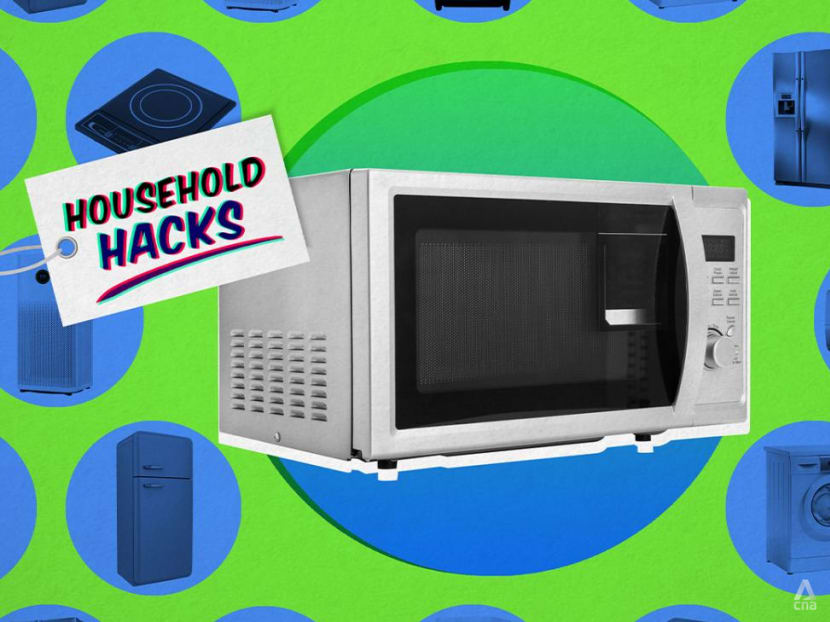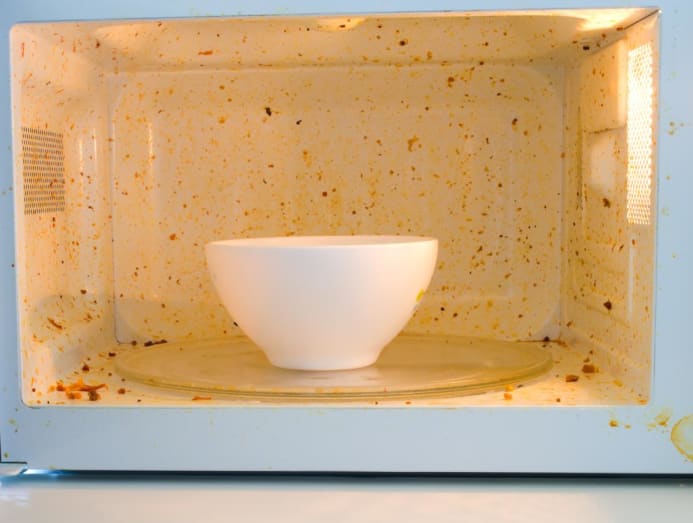Why is my food still cold? What do I do when I see sparks? Your microwave oven questions answered
That and other questions, including the turntable not rotating, a blown light and a malfunctioning control panel answered in this new Household Hacks series.

(Art: Jasper Loh)
When it comes to the microwave oven, you’re probably an old hand at using it. Reheating last night’s leftovers or thawing that hunk of meat? Pffft, easy peasy. Even hacks such as baking a cake in a mug or making scrambled eggs are no problem.
And you’d already know what not to put in the microwave oven. A recap: No metal, plastic (especially the disposable type), styrofoam and eggs with shells intact, to name a few.
But despite avoiding the no-nos, there are days when your microwave oven does act up. To help you understand what’s going on when your oven refuses to work, we got Dr Quek Yang Thee, the programme chair of Republic Polytechnic’s Diploma in Engineering Systems & Management course, to explain how it works and to break down the various common scenarios and what you can do:
HOW THE MICROWAVE OVEN WORKS
Every microwave oven comes with an electron tube called a magnetron – and it is this part that produces the microwaves, said Dr Quek. When in use, the produced microwaves are reflected in the oven and bounce around.
When these waves hit your plate of fried rice, for instance, they get absorbed by the food and vibrate the water molecules in the food, explained Dr Quek. As a result of the intense vibration, the fried rice gets heated up.
There are two types of microwave ovens: The turntable and the flatbed. The main difference is, the former has a rotating plate, whereas the other doesn’t but uses a rotating antenna to distribute the microwaves, said Dr Quek.
SCENARIO 1: The oven appears to be running but the food doesn't heat up
As explained earlier, you need microwaves and water molecules for the oven to produce heat. So, it could be either of these factors: There is no microwave produced (meaning, the magnetron is not functioning) or there is no water content in the food (such as cereal, grains or anything dry), said Dr Quek.
“There can be other reasons, too. The interior of the oven could be covered with so much food spillages or splatters that they absorb or block the microwaves from heating up the intended food,” he said.

To check for malfunction and to get your oven working again, Dr Quek has these suggestions:
- Test the oven by heating up some water. Place a bowl of water in the oven and if the water heats up, your oven is still working.
- Clean the oven’s interior. Ensure the top, bottom and walls of the oven aren’t covered with food stains.
- Check that the turntable is rotating when the oven is in use. If not, is the food so big that it prevents the turntable from rotating?
SCENARIO 2: The touch panel doesn't work
This problem is getting more common as ovens now have touch panels instead of dials or buttons, said Dr Quek. According to him, wear and tear, and having more settings on the control pad could be a reason for the touch panel to get touchy.
Try varying the way you press the buttons to get contact, he suggested. If that doesn’t help, “it will be tough to repair” and your best recourse is a new oven, especially if it’s still under warranty.
“Heat may be another potential cause when the oven is used for prolonged periods and eventually overheats. I would suggest giving the oven a rest and try again.”
To prevent this issue, don’t exert too much pressure when selecting the function on the touch panel, said Dr Quek. “And don’t keep pressing it.”
SCENARIO 3: You have to put the food back into the oven a few times to heat it up sufficiently
You probably already know that you need to spread your food on a plate for it to heat up evenly. But did you know that the right way to spread is to create a ring with your food (imagine a doughnut) or leave the least amount in the middle of the plate?
“This is because, as the turntable rotates, the centre of the plate is the only spot that doesn’t move. Therefore, it has the least chance of getting heated up,” said Dr Quek.
Also, don’t stack plates of food on top of each other, or put in big or heavy items that prevent the turntable from rotating. “The purpose of the rotating turntable is to let the food get hit by the microwaves,” said Dr Quek.

If your chicken or other food is too big, cut or chop it into smaller pieces. The more surface area you create in your food, the more efficient it’ll be for the microwaves to do their work, he added. “You might also want to place a cover over the food to contain the water.”
SCENARIO 4: The oven runs for a while then stops
There are many reasons for this, said Dr Quek. The circuit board or transformer has malfunctioned, or the user has used the wrong setting. Ceasing to work could also be a built-in safety feature that gets triggered when the oven door is not closed properly or cannot close, he said.
“The main thing is, if you smell smoke or something bad, see sparks, or the microwave is vibrating unusually, stop using it immediately,” he advised.
So, should you send it in for repair or get a new one? “If it doesn’t cost much to get a new oven, why not replace it? There might be other underlying issues, such as a microwave leakage, which we can’t see with our naked eyes,” said Dr Quek.
SCENARIO 5: The plate does not rotate
You might have accidentally activated a function that stops the rotation, said Dr Quek. “There are some multi-purpose ovens that have a grilling feature and activating it might stop the turntable.”
Or it could be caused by a malfunctioned rotating motor but that is very rare, according to Dr Quek. If that is the case, you’ll need to get it repaired.

Another possible reason is that the wheels or roller guides underneath the plate have come off their tracks. Check your owner’s manual to put them back as different oven models have different roller guides.
If the roller guide is broken (and that is why you shouldn’t place a big chicken or oversized leg of lamb in the microwave oven), you might be able to find the replacement parts in the hardware store, said Dr Quek.
While you’re checking the roller guides, see that there isn’t any food spillage caking the wheels and preventing them from moving, said Dr Quek. If there is, that's gross. Clean it up.
SCENARIO 6: There are sparks but you haven't placed any metal inside the oven
“Sometimes, food with a high mineral content like iron and magnesium might cause some sparks if they are cut into pieces with edges,” said Dr Quek. For such food, you might want to put them in a sauce of water to reduce the possibility of sparks, he suggested.
However, if you are sure there is no metal in the cooking chamber of the oven, the sparks could be caused by a faulty component. Stop using the oven, and get it repaired or replaced.

SCENARIO 7: The bulb doesn't light up when the oven is operating
The bulb is usually tucked away in the oven, so it is not easy to get damaged or hit by objects, according to Dr Quek. But it can blow due to long hours of use. Furthermore, the bulb can seem spoiled when it is covered by a mini explosion of food; another good reason to clean up your mess to avoid confusing it for a blown bulb.
The good news is, the bulb isn’t essential to the heating and cooking process. “I see it as a safety feature or indicator whether the door is open or not, and whether the microwave is switched on,” said Dr Quek.
Having said that, the bulb also lets you observe the process. “Remember that your food is cooked in a closed box and without the light, you will not be able to see if your food has already burned or boiled over before the timer is up,” he said.

Should you replace the bulb then? “It is the chef’s decision to make,” he said. Does the chef need to see how well the food is cooked? Does the food need monitoring while it’s cooking?
In the meantime, don’t overwork the oven and let it rest after some use. “Even though it is a machine, give your oven time to rest if needed,” said Dr Quek.
It also helps to take note of where you place the microwave oven. Due to a small kitchen, you might squeeze the appliances together and that might not be a good idea, he said. “For example, the heat from the stove might cause some damage to the oven if it is near it.”






